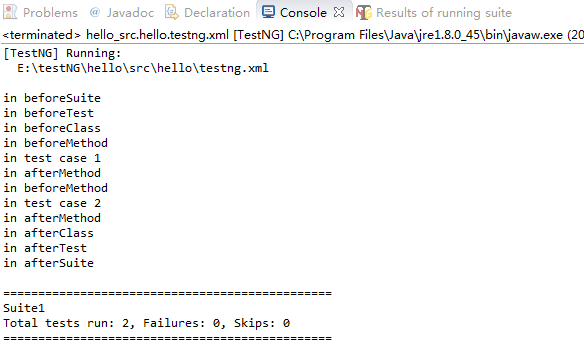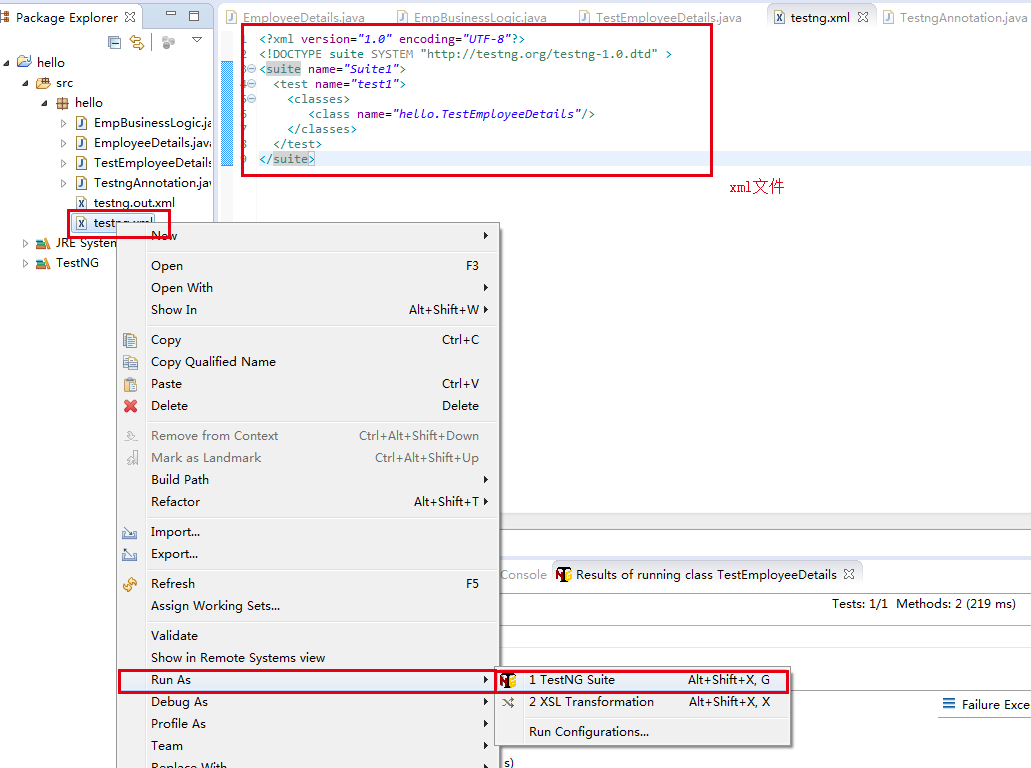1.介绍
testNG,也就是testing,Next Generation,下一代测试技术,是一套根据JUnit和NUnit思想而构建的利用注释来强化测试功能的一个测试框架,可以用来做单元测试,也可以做集成测试。
因为testNG是从junit的思想构建而来,所以testNG具备junit等所不具备的多重功能。而且testng目前的使用比较广防,google的一个delenium自动化项目组即采用的是seleniumrc的Java接口+testNG结合的方式。testNG是一个设计用来简化广泛的测试需求的测试框架,从单元测试(隔离测试一个类)到集成测试(测试由多个类多个包甚至多个外部框架组成的整个系统,例如运用服务器)。
testNG测试过程三个典型的步骤
编写测试的业务逻辑并在代码中插入TestNG annotation
将测试信息添加到testng.xml文件或者build.xml中
运行TestNG
2.对比
a、testNG是一个设计用来简化广泛测试需求的测试框架,从单元测试到集成测试。这个是testNG设计的出发点,不仅仅是单元测试,而且可以用于集成测试。设计目标的不同,对比junit的只适合用于单元测试
b、测试的过程的三个典型的步骤,多了一个将测试信息添加到testing.xml文件或者build.xml.测试信息尤其是测试数据不再写死在测试代码中,好处就是修改测试数据是不需要修改代码/编译了,从而有助于将测试人员引入单元测试/集成测试
c、相比于junit的testCase/testSuit,testNG有suit/test/test method三个级别,也就是把test/test method明确分开了。
3.testNG使用的概念
suite由xml文件描述。它包含一个或多个测试并定义为<suite>标签
test由<test>描述并包含一个或多个testNG类
testNG类是包含至少一个 testNGannotation的Java类,由<class>标签描述并包含一个或多个测试方法
测试方法是源文件中带有@testd注释的Java方法
4.Annotation(注释)
|
注解 |
描述 |
|
@BeforeSuite |
注解的方法将只运行一次,运行此套件的所有测试前。 |
|
@AfterSuite |
注解的方法将只运行一次此套件中的所有测试都运行之后。 |
|
@BeforeClass |
注解的方法将只运行一次,被注释的方法将在当前类的第一个测试方法调用前运行 |
|
@AfterClass |
注解的方法将只运行一次,被注释的方法将在当前类的所有测试方法调用后运行 |
|
@BeforeTest |
被注释的方法将在测试运行前运行 |
|
@AfterTest |
被注释的方法将在测试运行后运行 |
|
@BeforeGroups |
被配置的方法将在列表中的gourp前运行。这个方法保证在第一个属于这些组的测试方法调用前立即执行。 |
|
@AfterGroups |
被配置的方法将在列表中的gourp后运行。这个方法保证在最后一个属于这些组的测试方法调用后立即执行。 |
|
@BeforeMethod |
被注释的方法将在每一个测试方法调用前运行 |
|
@AfterMethod |
被注释的方法将在每一个测试方法调用后运行。 |
|
@DataProvider |
标记一个方法用于为测试方法提供数据。 |
|
@Factory |
标记方法作为一个返回对象的工厂,这些对象将被TestNG用于作为测试类。这个方法必须返回Object[] |
|
@Listeners |
定义一个测试类的监听器。 |
|
@Parameters |
描述如何传递参数给@Test方法value用于填充这个方法的参数的变量列表 |
|
@Test |
标记一个类或方法作为测试的一部分。 |
测试一下annotation的结果
package hello;
importorg.testng.annotations.Test;
importorg.testng.annotations.BeforeMethod;
importorg.testng.annotations.AfterMethod;
importorg.testng.annotations.AfterSuite;
importorg.testng.annotations.BeforeClass;
importorg.testng.annotations.AfterClass;
importorg.testng.annotations.BeforeTest;
importorg.testng.annotations.AfterTest;
importorg.testng.annotations.BeforeSuite;
public classTestngAnnotation {
// test case 1
@Test
public void testCase1(){
System.out.println("in test case 1");
}
// test case 2
@Test
public void testCase2(){
System.out.println("in test case 2");
}
@BeforeMethod
public voidbeforeMethod() {
System.out.println("in beforeMethod");
}
@AfterMethod
public voidafterMethod() {
System.out.println("in afterMethod");
}
@BeforeClass
public voidbeforeClass() {
System.out.println("in beforeClass");
}
@AfterClass
public voidafterClass() {
System.out.println("in afterClass");
}
@BeforeTest
public voidbeforeTest() {
System.out.println("in beforeTest");
}
@AfterTest
public void afterTest(){
System.out.println("in afterTest");
}
@BeforeSuite
public voidbeforeSuite() {
System.out.println("in beforeSuite");
}
@AfterSuite
public voidafterSuite() {
System.out.println("in afterSuite");
}
}根据上面的输出,testNG的annotation的执行过程如下:
首先所有beforeSuite()方法只执行一次
最后,afterSuite()方法只执行一次

最后,afterSuite()方法只执行一次
即使方法beforeTest(), beforeClass(), afterClass() 和afterTest()方法只执行一次
beforeMethod()方法执行每个测试用例,但在此之前执行的测试用例。
afterMethod()方法执行每个测试用例,但测试用例执行后
测试用例在beforeMethod()和afterMethod()之间执行
5.编写测试
创建EmployeeDetails.java
EmployeeDetails类是用来
--get/set员工名字的值
--get/set员工月薪的值
--get/set员工年龄的值
packagehello;
public classEmployeeDetails {
private String name;
private double monthlySalary;
private int age;
/**
* @return the name
*/
public String getName() {
return name;
}
/**
* @param name thename to set
*/
public void setName(String name) {
this.name =name;
}
/**
* @return themonthlySalary
*/
public double getMonthlySalary() {
return monthlySalary;
}
/**
* @parammonthlySalary the monthlySalary to set
*/
public void setMonthlySalary(doublemonthlySalary) {
this.monthlySalary =monthlySalary;
}
/**
* @return the age
*/
public int getAge() {
return age;
}
/**
* @param age theage to set
*/
public void setAge(intage) {
this.age =age;
}
}
创建一个EmpBusinessLogic.java
EmpBusinessLogic类用于计算
员工的年薪
考核支付雇员
packagehello;
public classEmpBusinessLogic {
//Calculate the yearly salary of employee
public double calculateYearlySalary(EmployeeDetails employeeDetails){
double yearlySalary=0;
yearlySalary = employeeDetails.getMonthlySalary() * 12;
return yearlySalary;
}
//Calculate the appraisal amount of employee
public double calculateAppraisal(EmployeeDetails employeeDetails){
double appraisal=0;
if(employeeDetails.getMonthlySalary() < 10000){
appraisal = 500;
}else{
appraisal = 1000;
}
return appraisal;
}
}现在,让我们创建一个TestNG 类名称为TestEmployeeDetails.java.TestNG类是一个Java类,它包含至少一个TestNG的注解。 这个类包含测试用例进行测试。可以配置,@BeforeXXX和@AfterXXX注解了TestNG测试,它允许执行一些Java逻辑的目标点之前和之后。
TestEmployeeDetails测试方法,用于类EmpBusinessLogic,它
雇员测试的年薪
测试评估员工的金额
packagehello;
importorg.testng.Assert;
importorg.testng.annotations.Test;
public classTestEmployeeDetails {
EmpBusinessLogic empBusinessLogic = new EmpBusinessLogic();
EmployeeDetails employee = newEmployeeDetails();
@Test
public voidtestcalCulateAppraisal() {
employee.setName("Rajeev");
employee.setAge(25);
employee.setMonthlySalary(8000);
double appraisal = empBusinessLogic.calculateAppraisal(employee);
Assert.assertEquals(500, appraisal,0.0,"8000");
}
@Test
public voidtestCalculateYearSalary(){
employee.setName("Rajeev");
employee.setAge(25);
employee.setMonthlySalary(8000);
double salary = empBusinessLogic.calculateYearlySalary(employee);
Assert.assertEquals(96000, salary,0.0,"8000");
}
}

同样我们也可以写testng.xml文件
<?xml version="1.0" encoding="UTF-8"?>
<!DOCTYPE suite SYSTEM"http://testng.org/testng-1.0.dtd">
<suite name="Suite1">
<test name="test1">
<classes>
<classname="hello.TestEmployeeDetails"/>
</classes>
</test>
</suite>










 本文详细介绍TestNG测试框架的概念、特点及使用方法。包括其相对于JUnit的优势、测试过程的典型步骤、核心注解及其执行顺序等内容,并通过具体示例演示如何进行单元测试。
本文详细介绍TestNG测试框架的概念、特点及使用方法。包括其相对于JUnit的优势、测试过程的典型步骤、核心注解及其执行顺序等内容,并通过具体示例演示如何进行单元测试。


















 178
178

 被折叠的 条评论
为什么被折叠?
被折叠的 条评论
为什么被折叠?








